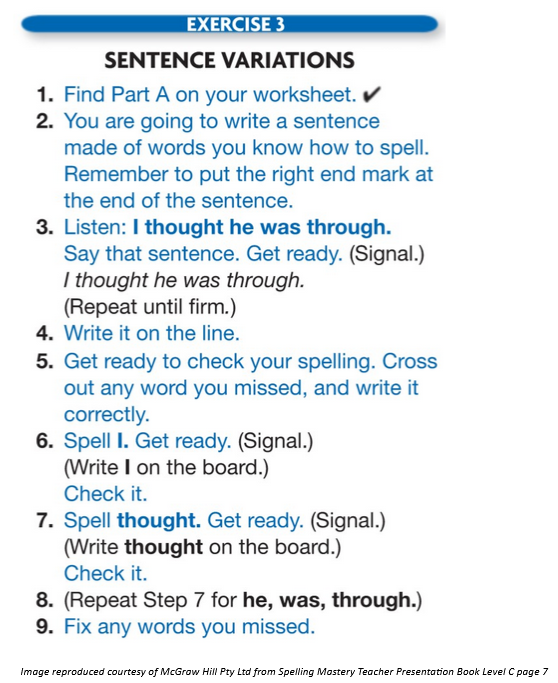Back to Course
Teach Spelling Mastery A-F
0% Complete
0/0 Steps
-
Module Introduction5 Topics
-
Overview18 Topics|3 Tests
-
Cover
-
Lesson Objective
-
Opening the Lesson
-
Spelling Mastery Training
-
Teach to Mastery
-
Whole-Word Approach
-
Phonemic Approach
-
Morphemic Approach
-
Check Your Understanding
-
Teaching Materials
-
Level A–F student workbooks
-
Teach in Tracks
-
Video – Spelling Mastery in Action
-
Check Your Understanding
-
Video – Arthur S talks about Spelling Mastery
-
Test Your Understanding
-
Review
-
Lesson Completed
-
Cover
-
Using Program Materials and Organising the Classroom16 Topics|3 Tests
-
Cover
-
Lesson Objective
-
Opening the Lesson
-
Placement Tests
-
Determine Levels
-
Give the Placement Test
-
Video – Spelling Mastery Placement Test
-
Placement Criteria
-
Check Your Understanding
-
Case Study
-
Organise the Space
-
Video – Active monitoring
-
Check Your Understanding
-
Test Your Understanding
-
Review
-
Lesson Completed
-
Cover
-
Teacher Resources16 Topics|3 Tests
-
Cover
-
Lesson Objective
-
Opening the Lesson
-
The Script
-
Features of a Script
-
Delivering a Script
-
Video – Spelling Mastery A Lesson 18, Exercise 3
-
Check Your Understanding
-
Teacher’s Guide
-
Series Guide
-
Questions and answers
-
Check Your Understanding
-
Video – Spelling Mastery Use of Series Guide and Teacher’s Guide
-
Test Your Understanding
-
Review
-
Lesson Completed
-
Cover
-
Signalling15 Topics|3 Tests
-
Cover
-
Lesson Objective
-
Opening the Lesson
-
Signals Rationale
-
Parts of a Signal
-
Auditory signal
-
Video – Auditory signal
-
Check Your Understanding
-
High Standards
-
Practice Makes Perfect
-
Video – Examples and Non Examples of Signalling
-
Check Your Understanding
-
Test Your Understanding
-
Review
-
Lesson Completed
-
Cover
-
Active Monitoring14 Topics|2 Tests
-
Cover
-
Lesson Objective
-
Opening the Lesson
-
Keep Students on Task
-
Video 8 – Active Monitoring
-
Practise the Tick Mark
-
Evaluate Independent Work
-
Check Your Understanding
-
Rules for Active Monitoring
-
Rules for Active Monitoring continued
-
Video 11 – Spelling Mastery B, lesson 111
-
Test Your Understanding
-
Review
-
Lesson Completed
-
Cover
-
Pacing and Transitions18 Topics|3 Tests
-
Cover
-
Lesson Objective
-
Opening the Lesson
-
Pacing Explained
-
Perky Pace
-
Lesson Delivery
-
Benefits of Perky Pace
-
Video – Spelling Mastery B Lesson 10 exercise 1
-
Check Your Understanding
-
Program Expectations
-
Transitions and Routines
-
Check Your Understanding
-
Video – Effective Transitions
-
Practise Makes Perfect
-
Video – Spelling Mastery B Lesson 111 Pacing and transitions
-
Test Your Understanding
-
Review
-
Lesson Completed
-
Cover
-
Motivating Students20 Topics|3 Tests
-
Cover
-
Lesson Objective
-
Opening the Lesson
-
Direct Instruction
-
Enthusiasm
-
Point Systems
-
Oral Work Guidelines
-
Written Work Guidelines
-
Bonus
-
Check Your Understanding
-
Video – Lisa Brodbeck Talks About Motivation
-
Teacher/Student Game
-
Video – Teacher/Student Game Introduction
-
Game Guidelines
-
Awarding Points
-
Check Your Understanding
-
Video – Teacher Teaching Lesson with Teacher/Student Game
-
Test Your Understanding
-
Review
-
Lesson Completed
-
Cover
-
Individual Turns16 Topics|2 Tests
-
Cover
-
Lesson Objective
-
Opening the Lesson
-
Understanding Individual Turns
-
Present to the Group
-
Procedure
-
Video – Spelling Mastery Exercise with Individual Turns
-
Guidelines
-
Give Every Student an Opportunity
-
Check Your Understanding
-
Tracking Individual Turns
-
Student mastery
-
Video – RMSE K With Individual Turns
-
Test Your Understanding
-
Review
-
Lesson Completed
-
Cover
-
Correcting Errors16 Topics|2 Tests
-
Cover
-
Lesson Objective
-
Opening the Lesson
-
Correcting Errors
-
Types of Student Errors
-
Correction Procedure for Specific Errors
-
Correction Procedure Example
-
Check Your Understanding
-
Scenario of a Teacher Correcting a Response Error
-
Video – Correction Procedure
-
Task-specific Error Corrections
-
Error Correction Practice
-
Video – Model, Lead, Test, Retest
-
Test Your Understanding
-
Review
-
Lesson Completed
-
Cover
-
Correcting General Errors15 Topics|2 Tests
-
Cover
-
Lesson Objective
-
Opening the Lesson
-
General Errors
-
Types of Errors and Correction Procedures
-
Error Correction Example
-
Video – General Error Corrections
-
Check Your Understanding
-
Correction Tips
-
Scenario of Teacher Correcting a General Error
-
Positive Corrective Feedback
-
Video – Providing Positive Corrective Feedback
-
Test Your Understanding
-
Review
-
Lesson Completed
-
Cover
-
Mastery Tests and Data Collection20 Topics|3 Tests
-
Cover
-
Lesson Objective
-
Opening the Lesson
-
Ensuring Understanding
-
Assessing Understanding
-
Reinforcing Understanding
-
Bonus Activity Points
-
Check Your Understanding
-
Video – Spelling Mastery A, Lesson 15, exercises 2 and 3
-
Test Procedure
-
Remedy Retesting
-
Check Your Understanding
-
Video – Giving a mastery test
-
Attendance on SPT
-
Lesson Progress on SPT
-
Record Independent Work
-
Mastery Tests on SPT
-
Test Your Understanding
-
Review
-
Lesson Completed
-
Cover
-
Module Review20 Topics|2 Tests
-
Cover
-
Lesson Objective
-
Opening the Lesson
-
Spelling Mastery Overview
-
Student Placement
-
Teaching Script
-
Auditory Signal
-
Video – Auditory Signal
-
Check Your Understanding
-
Active Monitoring
-
Video – Active Monitoring
-
Perky Pacing
-
Behaviour Management
-
Individual Turns
-
Error Correction
-
Regular Assessment
-
Video – Spelling Mastery B, Lesson 106
-
Test Your Understanding
-
Review
-
Lesson Completed
-
Cover
-
Module evaluation survey1 Topic
Lesson Progress
0% Complete

Whole-Word Approach
The whole-word approach is based on memorisation. This is the only way to teach words that do not fit generalisations. However, this approach has a limited use as there are too many words to memorise to rely on this approach alone. Irregularly spelled words of high utility are taught using the whole-word approach.


